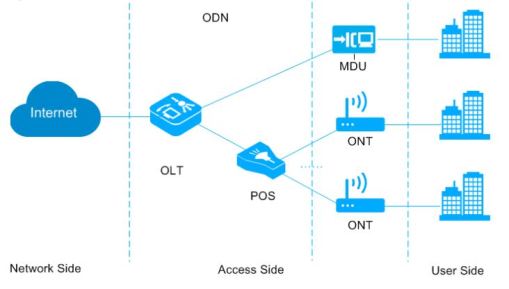Hello friends and welcome to all of you once again on your own website. Today I am going to tell you What is GPON (Gigabit Passive Optical Networks) Technology? As you know Increasing demand for Internet bandwidth thanks to video streaming, content sharing, social media applications and online gaming is consistently pushing the need for higher bit rates and better experiences. the final word response from operators, governments and utilities is to deploy fiber-to-the-home (FTTH) using GPON technology, which provides ultra-broadband access for home and office users, ensuring a superb experience with VoIP, Internet and HD video services.
GPON (Gigabit Passive Optical Networks) is a fiber optic technology (GPON Technology) that allows a higher speed of transmission and reception of data through a single fiber. With a point-to-multipoint architecture, it will enable optical fiber to the home, or a building. It allows access to Video, Voice, and Data and arose with the need to enhance copper networks. Now, copper and state-of-the-art fiber optic offer solutions adapted to each need.
Table of Contents
What Is GPON (Gigabit Passive Optical Networks) Architecture & Features
A GPON network is capable of transmitting multiplexing divided by time (TDM), Ethernet, and ATP traffic. This kind of networks consists of an OLT (Optical Line Terminals) unit, an ONU (Optical Network Unit) and a splitter. The splitter will redirect the signal when necessary. The OLT unit takes all the optical signals within the sort of light beams from the ONUs and converts them into electrical signals. OLTs typically support up to 72 ports. An ONU connects end users and forwards the signal back to the OLTs. A GPON Network supports a physical distance of up to 20 Km and may provide service upto 64 end users. GPON uses upstream and downstream data using Optical Wavelength Division Multiplexing (WDM).
• Protocol level security: Basic Encryption
• Downstream speed: 2.4 Gbps
• Upstream speed: 1.2 Gbps
• Logic maximum distance: 60 km
• Physical Maximum distance: 20 km

The basic concepts about GPON are as follows:
- OLT: indicates an optical line terminal that is an aggregation device placed at the central office to terminate the PON protocol.
- ONU: indicates an optical network unit that is a network device connected to the user side. It is responsible for forwarding upstream data to the user side and selectively receiving downstream broadcast data from the OLT. Generally, it is placed near end users, for example, in the corridor, at home, or along the roadside.
- ONT: indicates an optical network terminal that provides the same function as an ONU. The difference is that the ONT is directly connected to end users but another network may exist between the ONU and end users.
- POS: indicates a passive optical splitter that connects the OLT and ONUs. It splits one input into multiple inputs, and is not connected to any external power. It centralizes upstream data and delivers downstream data. It is difficult to monitor the POS because it is a passive device; therefore, it severely affects network maintenance.
- ODN: indicates a pure passive optical distribution network that consists of passive optical components such as optical fibers and cables, optical connectors, and optical splitters. It provides the optical transmission channels between the OLT and ONUs.
What Is An E-SIM: Everything You Must-Have To Know In 2021?
GPON TOP Features
- Allows fiber connections up to 20 kilometers between the OLT and the ONT. This is a good advantage because the old xDSL connections only reach a maximum of 5.5 kilometer at a lower cone connection speed. It doesn’t need active intermediate equipment between the OLT and therefore the ONT. It simplifies the deployment of fiber and allows far more straightforward and cheaper network typologies. Remember that splitters are passive elements.
- Considerable reduction of costs for the operator because it allows sending many services at an equivalent time though an equivalent fiber connection. because of the multiplexing we will simultaneously send:
- Voice (VoIP phone)
- Data (Internet)
- TV and video (Multicast). we will send digital television in high definition (IPTV), video on demand (VOD), analog broadcast by RF.
- The operation and maintenance for the operators also are simpler because GPON has remote management of the user’s equipment (ONT), download updates, operating parameters, and more.
GPON Disadvantages
• Installers must take care with mechanical joints to avoid losses and attenuations. they have specialized personnel and equipment to form fiber splices.
• Identification and correction of the reflection are within the downstream channel (downstream from the OLT to the user’s ONT) and therefore the ascending channel (upstream from the ONT to the switchboard with the OLT).

1 thought on “WHAT IS GPON (Gigabit Passive Optical Networks) TECHNOLOGY”